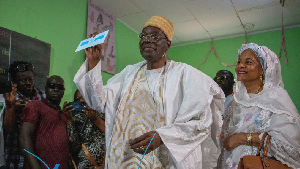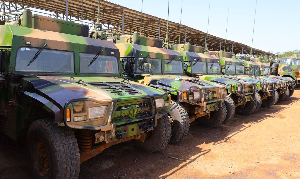On June 30, 2014, the Executive Board of the International Monetary Fund (IMF) concluded the Article IV consultation with Cameroon1 and considered and endorsed the staff appraisal without a meeting.2
The pace of economic growth accelerated in 2013, reaching 5.5 percent (compared to 4.6 percent in 2012). Average annual inflation remained subdued at 2.1 percent, because food prices remained stable and fuel prices, controlled. Growth was particularly buoyant in the services and construction sectors, the latter supported by strong public investment. The higher demand for capital goods led to an increase in imports, which offset the improving export performance of the oil sector.
Cameroon's robust economic performance since 2007 does not appear to have dented poverty significantly. Recent estimates show a slight decrease from 39.9 percent of the population in 2007 to 38.7 percent in 2011, while growth incidence curves indicate that inequality may have increased.
The fiscal situation deteriorated in 2013. Oil revenue, which represented more than a quarter of all revenue, was lower than expected, because oil production and prices remained stable, but production costs increased. Retail fuel subsidies reached 2.8 percent of GDP and externally financed capital expenditure surged to 3.4 percent of GDP. These developments led to a budget deficit (on a cash basis) of over 4 percent of GDP, versus 2 percent of GDP in 2012.
Cameroon's debt burden remains low, thanks in part to extensive debt relief in 2006, but it is growing at a fast pace. As a result of new nonconcessional external debt, the debt sustainability analysis shows that Cameroon's risk of external debt distress has increased from "low" to "moderate". On current trends, overall public debt is slated to double as a percentage of GDP between 2012 and 2019.
There has been progress in the banking system, as two previously troubled banks were able to restructure their balance sheets. The regional supervisory authority is in the process of strengthening its human resources to increase the frequency of its supervisions. A major concern remains the excessive concentration in bank credit toward the financially fragile national oil refinery.
Economic growth is expected to remain at about 5.5 percent annually over the medium term under current policies, while inflation is projected to remain below the regional convergence criterion of 3 percent. Oil exports will be sustained by volume growth, although prices are projected to decrease gradually. Large public investment projects in infrastructure will continue to support non-oil growth over the next few years. The private sector's response to the new infrastructure is expected to take over as the main driver of growth thereafter, assuming a significant improvement in the business environment.
Substantial risks undermine Cameroon's development prospects. Regional insecurity has deteriorated markedly over the past year. Fuel subsidies and a weak revenue effort continue to undermine a more pro-poor and pro-growth budget; and limited progress in improving the business environment stymies the advent of the formal private sector.
Executive Board Assessment
In concluding the 2014 Article IV consultation with Cameroon, Executive Directors endorsed staff's appraisal, as follows:
Cameroon's increased public investment spending has accelerated growth. The authorities need to implement higher quality policies and improve governance to promote development. The current level of growth, in itself, is not sufficient to accelerate poverty reduction and achieve upper-middle-income country status by 2035. A combination of reforms to enhance the cost-effectiveness of public expenditure and to foster private sector response has become critical. Regional security risks add an element of urgency to reforms to make the economy more resilient and to rekindle regional integration.
The fiscal stance requires adjustment. Risks to the 2014 budget need to be addressed without delay to avoid further accumulation of domestic arrears that undermine fiscal sustainability. Non-oil revenue performance will remain tepid unless unwarranted exemptions are removed, the tax base is broadened, and tax administration is made more effective. International oil prices and domestic demand will keep fuel subsidies high, unless pump prices are progressively raised. Contingent liabilities in the public and banking sectors and Public Private Partnerships (PPP) threaten fiscal sustainability.
The envisaged ratification of the Economic Partnership Agreement (EPA) could further undermine revenue in the long term. An evaluation of its direct and indirect impacts on revenue is necessary, and could inform new discussions on regional integration with the Central African Economic and Monetary Community (CEMAC) partner countries.
Although debt remains sustainable, new external liabilities have pushed the risk of external debt distress from "low" to "moderate." The level of external debt remains low relative to the average of Sub-Saharan Africa (SSA) but the pace of debt accumulation is faster, and the risk of external debt distress would be higher still if the composition of future financing were to preserve or exceed external levels observed in 2013 and expected for 2014, rather than gradually decreasing as currently projected. The sensitivity of external debt sustainability to exports calls for export diversification.
The projected external debt accumulation points to a need to generate more value from public investment. A three-pronged approach is necessary: (i) a new round of project selection to identify projects with a high impact on growth and poverty reduction, and the rolling back of non-essential projects; (ii) the integrity of public financial management needs to be strengthened, including competitive procurement to generate more cost-effective spending; and (iii) the terms of new debt need to be more concessional.
A broad array of reforms to the business environment needs to be initiated, because its credibility will take time to establish. The private sector needs to take over as the main engine of growth by the time the public investment program is scaled back. The various reform areas cited by the Doing Business indicators point to a direct link between improvements in revenue policy, public financial management and private sector activity; they include "trading across borders" and "paying taxes".
Risks to the banking system have receded, but financial intermediation remains low. The restructuring of two troubled banks leaves only three small banks in need of a resolution. The microfinance sector could expand faster and with less risk with the adoption of a regulatory framework and diligent joint supervision by the Commission Bancaire de l'Afrique Centrale (COBAC) and the Ministry of Finance. The new bank for Spell and Medium Enterprises (SME) is in need of regulatory vigilance, starting with its credit policy.
Cameroon: Selected Economic and Financial Indicators, 2012-15
3-Apr-13 2012 2013 2014 2015
Act. Est. Proj. Proj.
(Annual percentage change, unless otherwise indicated)
National income and prices
GDP at constant prices
4.6 5.5 5.5 5.5
Oil GDP at constant prices
3.5 3.0 4.5 9.0
Non-oil GDP at constant prices
4.6 5.6 5.6 5.4
GDP deflator
3.1 1.5 2.1 1.9
Consumer prices (average)
2.4 2.1 2.2 2.2
External trade
Export volume
8.3 3.0 7.6 9.5
Of which: non-oil sector
8.4 1.8 7.2 9.5
Import volume
2.2 6.5 8.2 7.6
Terms of trade ("-" is a deterioration)
0.3 0.9 0.1 -3.3
Money and credit
Net domestic assets1
4.6 10.1 7.5 7.9
Net credit to the public sector1
-2.3 -1.1 -1.0 -0.9
Credit to the private sector
2.6 14.9 11.1 11.2
Broad money (M2)
1.4 10.8 7.1 7.5
(Percent of GDP, unless otherwise indicated)
Central government operations
Total revenue (excluding grants)
17.5 17.8 18.0 17.7
Non-oil revenue (percent of non-oil GDP)
13.5 14.0 14.4 14.3
Total expenditure
19.5 22.1 24.0 23.9
Overall fiscal balance (cash basis)
Excluding grants
-2.9 -4.4 -6.1 -6.2
Including grants
-2.5 -4.1 -5.6 -5.7
Non-oil primary balance (percent of non-oil GDP)
-6.9 -9.1 -10.3 -9.9
External sector
Current account balance (including grants)
-3.6 -3.9 -3.8 -4.2
Imputed reserves (percent of broad money)
54.2 47.6 44.1 40.6
Public debt
Total
15.6 19.5 24.0 28.0
External
9.0 12.5 14.7 16.4
1 Percent of broad money at the beginning of the period.
Sources: Cameroonian authorities; and IMF staff estimates and projections.
1 Under Article IV of the IMF's Articles of Agreement, the IMF holds bilateral discussions with members, usually very year. A staff team visits the country, collects economic and financial information, and discusses with officials the country's economic developments and policies. On return to headquarters, the staff prepares a report, which forms the basis for discussion by the Executive Board.
2 Article IV consultations are concluded without a Board meeting when the following conditions apply: (i) there are no acute or significant risks, or general policy issues requiring Board discussion; (ii) policies or circumstances are unlikely to have significant regional or global impact; (iii) in the event a parallel program review is being completed, it is also being completed on a lapse-of-time basis; and (iv) the use of Fund resources is not under discussion or anticipated.
Infos Business of Thursday, 10 July 2014
Source: International Monetary Fund












